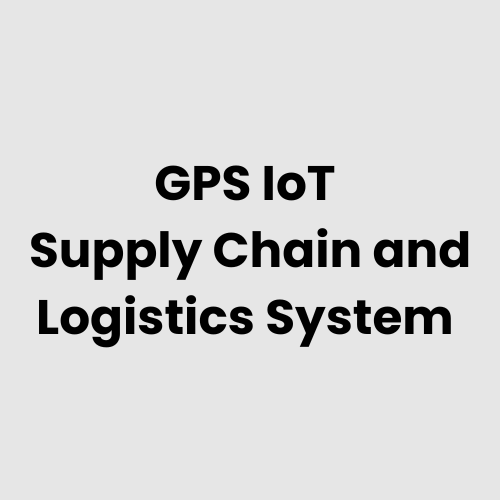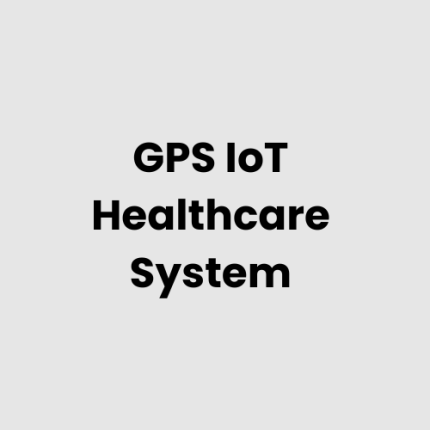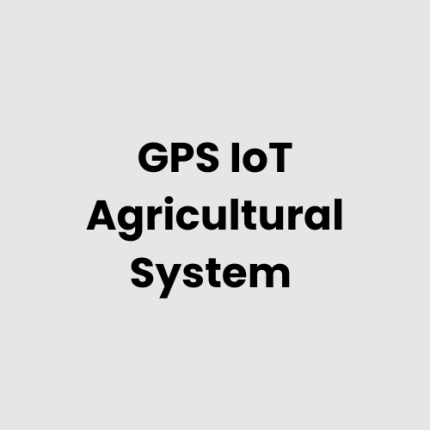Description
Technical Architecture of GPS IoT Enabled Supply Chain and Logistics IoT System
The GPS IoT Enabled Supply Chain and Logistics IoT System by GAO Tek is designed with a scalable and flexible architecture to optimize logistics operations. It comprises several components, including sensors, GPS devices, communication modules, and cloud-based analytics. These components work together to provide real-time data on inventory, vehicle status, and environmental conditions, enabling better decision-making and operational efficiency. Key elements include:
- IoT Sensors: Embedded in shipments and vehicles to capture data on temperature, humidity, pressure, and location.
- GPS Tracking Devices: Provide continuous real-time tracking of assets, vehicles, and shipments.
- Data Communication Network: Ensures secure and reliable data transfer between IoT devices and the cloud or local servers.
- Cloud Platform: Centralized data storage and processing for analytics and reporting.
- User Interface: Web and mobile apps for users to access data and manage the system.
Hardware of GPS IoT Enabled Supply Chain and Logistics IoT System
GAO Tek’s GPS IoT Enabled Supply Chain and Logistics IoT System utilizes a wide range of hardware components for seamless operation:
- GPS Trackers: Installed in vehicles and shipments to provide accurate, real-time location data.
- IoT Sensors: Deployed to monitor temperature, humidity, and other environmental factors for sensitive goods.
- Edge Computing Devices: Process data at the source, reducing latency for critical decisions.
- Gateway Devices: Facilitate communication between local IoT devices and the cloud.
- Cameras and RFID Tags: Capture visual and RFID-based data for tracking and monitoring purposes.
- Mobile Devices: Used by logistics personnel for real-time updates and communication.
- Cloud Servers: For storing data, running analytics, and supporting IoT integration.
Physical Placement Considerations of the Hardware
The physical placement of the hardware plays a crucial role in the effectiveness of the GPS IoT Enabled Supply Chain and Logistics IoT System:
- Vehicle Installation: GPS trackers and environmental sensors are installed in trucks, containers, and other mobile units to ensure real-time data transmission.
- Warehouse Deployment: IoT sensors and RFID tags are strategically placed throughout warehouses and distribution centres for inventory management and monitoring of goods in transit.
- Shipping Containers: Sensors are placed within shipping containers to track conditions and ensure safety during transit.
- Mobile Devices: Carried by logistics teams for on-the-go updates and operational management.
- Data Collection Points: Positioned at strategic points within logistics hubs to collect data from trucks, assets, and products.
Hardware Architecture of GPS IoT Enabled Supply Chain and Logistics IoT System
The hardware architecture of the GPS IoT Enabled Supply Chain and Logistics IoT System follows a modular and distributed approach:
- End-Point Devices: These include GPS-enabled trackers, IoT sensors (temperature, humidity, motion), and RFID tags attached to goods and transport units.
- Communication Layer: Consists of gateways (Wi-Fi, Bluetooth, cellular, LoRaWAN) that facilitate secure data transmission from IoT sensors to edge computing devices or the cloud.
- Edge Processing Devices: Perform real-time data analysis and reduce the volume of data sent to the cloud by processing non-critical information on-site.
- Cloud Integration: All collected data is transmitted securely to cloud servers, where analytics platforms process and generate insights.
- User Interface Devices: The system is accessible via web and mobile platforms, providing stakeholders with critical insights and control.
Deployment Considerations for GPS IoT Enabled Supply Chain and Logistics IoT System
When deploying the GPS IoT Enabled Supply Chain and Logistics IoT System, several factors need to be considered:
- Scalability: The system must be scalable to accommodate growing fleets, warehouses, and distribution centres.
- Connectivity: The solution should support various communication protocols like cellular, Wi-Fi, and satellite to ensure continuous data transmission in different geographic regions.
- Integration: It should easily integrate with existing ERP, WMS (Warehouse Management Systems), and other logistics platforms used by the client.
- Data Security: Secure communication protocols and data encryption should be implemented to protect sensitive business and customer data.
- Maintenance: Regular maintenance and firmware updates for all devices to ensure system reliability.
- Power Supply: Power management strategies, such as battery backup or solar power, must be in place for remote IoT devices.
- Customization: Tailor the system to fit specific customer requirements, such as different types of goods or logistics operations.
Relevant Industry Standards and Regulations
GAOTek’s GPS IoT Enabled Supply Chain and Logistics IoT System complies with a wide range of industry standards and regulations, including:
- ISO 9001:2015 (Quality Management Systems)
- ISO 14001:2015 (Environmental Management Systems)
- IEEE 802.15 (Wireless Communication)
- RFID standards (ISO 18000, EPCglobal)
- FDA 21 CFR Part 11 (for regulated industries)
- AAR (Association of American Railroads) Standards
- GDPR (General Data Protection Regulation) for data privacy
- ASTM E2877-13 (Standard Guide for RFID in Supply Chain Management)
- ITU-T Y.2060 (Smart Transport and Logistics Communications)
Local Server Version: Running with a Local Server
The GPS IoT Enabled Supply Chain and Logistics IoT System is also available as a local server solution, where all data processing, storage, and analytics occur on-premises, ensuring:
- Data Control: Full control over sensitive data and local storage.
- Offline Capability: System functionality remains intact even without internet connectivity, as it can operate on local servers.
- Reduced Latency: Faster processing of local data, ideal for critical applications.
- Customization: Full system flexibility and customization for businesses with specific requirements or regulatory concerns.
Cloud Integration and Data Management
GAO Tek’s GPS IoT Enabled Supply Chain and Logistics IoT System is designed for seamless cloud integration, offering several advantages:
- Real-Time Data Analytics: Cloud integration allows for immediate data processing and access to analytics dashboards, providing insights into fleet performance, inventory status, and route optimization.
- Scalable Infrastructure: The system can scale with business growth, as cloud servers offer vast storage capacity and processing power.
- Remote Monitoring and Management: Cloud-based management allows for remote configuration, maintenance, and troubleshooting of the entire system, ensuring uptime and minimizing disruptions.
- Data Synchronization: Continuous synchronization between edge devices, local servers, and cloud platforms ensures a unified view of operations, even when multiple locations or remote areas are involved.
- Predictive Analytics: Cloud-based processing enables advanced analytics such as predictive maintenance, helping to anticipate equipment failures or supply chain disruptions before they occur.
By leveraging cloud technologies, GAO Tek’s GPS IoT Enabled Supply Chain and Logistics IoT System can help businesses enhance supply chain visibility, streamline operations, and make data-driven decisions in real-time, with unmatched flexibility and scalability.
GAO Case Studies of GPS IoT Enabled Supply Chain and Logistics IoT System
USA Cases
- Smart Freight Monitoring in Los Angeles
A logistics company in Los Angeles utilizes GPS IoT-enabled tracking devices to monitor freight movements in real-time. This system provides precise location tracking, ensuring timely deliveries and reducing fuel consumption by optimizing routes. It also allows proactive management of delays and improves customer satisfaction by providing accurate delivery estimates. - Inventory Tracking in Chicago
In Chicago, a major distribution centre implemented a GPS IoT system for inventory tracking across multiple warehouses. By leveraging real-time data, the system enables efficient stock management, reduces human error, and minimizes stock outs. Additionally, the technology provides insights into warehouse operations, optimizing storage space and order fulfilment. - Fleet Management in Houston
A fleet management company in Houston integrated GPS IoT technology to streamline its vehicle operations. The system offers real-time vehicle location updates, fuel consumption analysis, and driver performance monitoring. By utilizing this data, the company reduces operating costs, improves fleet efficiency, and enhances safety across its entire fleet. - Cold Chain Logistics in New York City
In New York City, a cold chain logistics provider uses GPS IoT-enabled sensors to monitor temperature-sensitive shipments. The real-time monitoring system alerts operators of any temperature deviations, ensuring compliance with regulatory standards and preventing spoilage of goods. This solution enhances the safety and quality of food and pharmaceutical deliveries. - Automated Supply Chain in Atlanta
A company in Atlanta incorporated GPS IoT technology to automate its supply chain processes. The system tracks shipments from production to delivery, automatically adjusting routes to avoid delays and traffic congestion. This minimizes lead times and enhances overall operational efficiency, leading to cost savings and improved service levels. - Retail Inventory Management in San Francisco
A retail logistics firm in San Francisco employs GPS IoT-enabled devices for tracking the movement of goods between distribution centres and retail stores. This system offers real-time insights into stock levels, reducing out-of-stock situations and improving inventory planning. It also supports the swift movement of goods across the supply chain, ensuring optimal retail operations. - Construction Equipment Monitoring in Denver
In Denver, a construction company utilizes GPS IoT technology to track heavy machinery and equipment used on construction sites. The system allows real-time monitoring of equipment locations, usage hours, and maintenance needs. By providing predictive maintenance alerts and tracking equipment utilization, the company reduces downtime and extends the lifespan of its assets. - Delivery Tracking in Miami
A logistics provider in Miami uses GPS IoT systems to track and optimize last-mile delivery routes. This solution ensures real-time tracking of packages, allowing customers to receive accurate delivery times. By optimizing routes based on traffic conditions and delivery schedules, the company enhances delivery speed, reduces costs, and improves customer experience. - Warehouse Automation in Dallas
A distribution company in Dallas implemented GPS IoT to automate warehouse operations, including inventory management and order picking. The system provides real-time data on stock locations, helping workers quickly find and retrieve items. This increases warehouse efficiency, reduces picking errors, and speeds up the order fulfilment process, which in turn enhances customer satisfaction. - Tracking in Port Logistics – Seattle
Port logistics in Seattle is enhanced by the use of GPS IoT systems that provide real-time tracking of container movements. The technology enables better coordination between port operators and shipping companies, improving vessel scheduling, reducing congestion, and optimizing container handling processes. This results in faster throughput and cost savings for logistics firms. - Supply Chain Visibility in Philadelphia
A supply chain company in Philadelphia integrated GPS IoT-enabled sensors to improve supply chain visibility from manufacturing to final delivery. The system provides actionable data on product movement, delays, and inventory levels, enabling better decision-making. It helps streamline operations, reduce losses, and improve supplier relationships by ensuring consistent product availability. - Agricultural Logistics in Kansas City
In Kansas City, an agricultural logistics company employs GPS IoT technology to track the movement of crops from farms to processing plants. This system ensures that perishable goods are transported under optimal conditions and on time. By offering real-time data on transit conditions and location, it minimizes spoilage and enhances the efficiency of agricultural supply chains. - Asset Management in Phoenix
A construction and mining company in Phoenix uses GPS IoT-enabled devices for managing equipment and machinery assets. The system provides real-time data on asset location, usage, and maintenance schedules. It helps ensure that equipment is properly maintained, reducing downtime and improving operational efficiency in the field. - Vehicle and Cargo Monitoring in San Diego
A shipping company in San Diego uses GPS IoT devices to monitor both vehicles and cargo. This system tracks delivery vehicles in real-time, providing data on location, speed, and route optimization. Additionally, it tracks cargo conditions, ensuring that temperature-sensitive goods are transported safely and reducing the likelihood of spoilage or damage. - Environmental Monitoring in Washington D.C.
A logistics provider in Washington D.C. utilizes GPS IoT technology to monitor the environmental conditions of goods in transit. This system tracks humidity, temperature, and exposure to light, ensuring the protection of sensitive goods like pharmaceuticals and electronics. The data allows for early intervention in case of adverse conditions, ensuring timely and secure delivery.
Canada Cases
- Transportation Optimization in Vancouver
In Vancouver, Canada, a logistics company uses GPS IoT-enabled tracking systems to optimize transport routes for deliveries. The system analyses real-time traffic data, weather conditions, and route history to suggest the most efficient paths. This reduces fuel costs and delivery times, improving the overall efficiency of the transportation network. - Supply Chain Monitoring in Toronto
In Toronto, Canada, a major retail chain integrates GPS IoT technology to monitor its supply chain from warehouse to store. The system provides real-time updates on inventory levels and delivery status, helping improve stock availability and reduce lead times. This enhances the efficiency of logistics and ensures a smoother customer experience in retail stores.
Navigation Menu for GPS IoT
- GPS IoT Trackers/Devices
- GPS IoT Tracking Accessories
- GPS IoT Tracking Resources
- GPS IoT – Cloud, Server, PC & Mobile Systems
Navigation Menu for IoT
- LORAWAN
- Wi-Fi HaLow
- Z-WAVE
- BLE & RFID
- NB-IOT
- CELLULAR IOT
- GPS IOT
- IOT SENSORS
- EDGE COMPUTING
- IOT SYSTEMS
Our products are in stock and can be shipped anywhere in the continental U.S. or Canada from our local warehouse. For any further information, please fill out this form or email us.
We are actively looking for partners who are like us located in the U.S. and Canada. For more information on partnering with GAO, please visit Partner with GAO Tek Inc.It lists various ways to partner with GAO, such as OEM Partnerships, Technology Integration, Distribution and Reselling Opportunities, Presenting at the Leading Event Tek Summit, Joint R&D Projects, Training and Consulting Services, Industry-Specific Collaborations, Research and Academic Partnerships.



